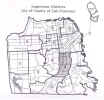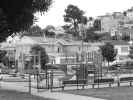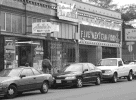District 9: Pandora's box
 The
hustings are bare this Labor Day weekend. Tom Ammiano has
flown south to meet with human rights activists in Chiapas.
At home in the Mission, signs of the upcoming campaign are
scarce. A few placards attached to utilities poles juxtapose
the names of Lucrecia (Bermudez) and (Ralph) Nader. At
Folsom and 26th, pastel flyers festoon the
headquarters of Valerie Tulier. But from the activity on 24th
Street, or Valencia, or Cortland Avenue, a visitor would
find it hard to believe that he was standing at the very
center of the whirlwind that will become this November’s
election. Or perhaps he would understand, for the eye of the
storm is proverbially quiet and so is District 9. For now.
The
hustings are bare this Labor Day weekend. Tom Ammiano has
flown south to meet with human rights activists in Chiapas.
At home in the Mission, signs of the upcoming campaign are
scarce. A few placards attached to utilities poles juxtapose
the names of Lucrecia (Bermudez) and (Ralph) Nader. At
Folsom and 26th, pastel flyers festoon the
headquarters of Valerie Tulier. But from the activity on 24th
Street, or Valencia, or Cortland Avenue, a visitor would
find it hard to believe that he was standing at the very
center of the whirlwind that will become this November’s
election. Or perhaps he would understand, for the eye of the
storm is proverbially quiet and so is District 9. For now.
In any case, the race for supervisor is
considered a done deal, with Ammiano expected to coast
toward victory on the coattails he himself spread out in the
mayoral election last fall. Unlike District 2, where no
candidate was willing to oppose incumbent Gavin Newsom, the
feisty district to the south has produced four people —
Bermudez, Tulier, Maria Martinez, and Ron Norlin — to keep
the Board of Supervisors president from getting too
comfortable. Progressive Left candidate Bermudez, in
particular, is outspoken in her criticism of what she
regards as his selling out in order to become "electable"
as mayor.
Oddly, given Bermudez’s history of fiery
confrontations with Ammiano, it is not the supervisor’s
race that clamors for attention in this district. Rather,
center stage has been seized by Proposition L, initiated by
the Campaign to Save San Francisco in an attempt to limit
office development in the Mission, Potrero Hill, and Hunters
Point. In the very center of the stage stands the Mission:
not only did local activists set up the springboard that
launched this controversial ballot measure; the very future
of the area depends on its passage.
But I’m telling the story backward. Let’s
take a look first at District 9 in its entirety. The
estimable David Binder tells us that it contains four major
neighborhoods: East Mission, Valencia Corridor, North Bernal
Heights, and South Bernal Heights. What he doesn’t tell us
is that this is a pretty pleasant spot to live in. It’s
easy to imagine Father Junipero Serra and his party of
soldier-settlers smiling with self-satisfaction as they
compared their sunny mission, irrigated by a stream and a
nearby lake, with the foggy wind-blown point on which their
military brethren had planted their presidio. Of course,
pleasant is in the eye of the beholder, and the hundreds of
Indians who succumbed to measles, smallpox, and venereal
disease may have had other thoughts. But the fault lay with
the proselytizers and not with the place itself.
The early Spaniards laid the warp of
future district’s fabric: the Mission became the point of
entry for successive waves of immigrants, making it the
exemplar of San Francisco’s diversity. In 1906 thousands
of Irish families left homeless by the earthquake moved here
from the south of Market. In the 1960s a guidebook reported
that, in addition to the substantial Latino population that
had replaced the Irish, there were Maltese, Norwegians,
Greeks, Portuguese, Russians, Italians, and Germans. Today
Latinos make up 48 percent of the district (compared to 13
percent citywide), with Anglos coming in second at 30
percent (compared to 47 percent citywide).
At the same time the Indians, whom the
Spanish padres set to weaving, farming, and generally doing
the day-to-day work of the mission, laid out the weft: the
area has traditionally been home to working-class people.
Today the residents’ median household income is $30,066,
more than 10 percent lower than the citywide equivalent.
Each
neighborhood of District 9 proudly displays its own
individual characteristics. In Bernal Heights, where dogs
seem to outnumber people, people tend to own their homes —
71 percent in South Bernal, compared to the district low of
20 percent in the Valencia Corridor and 45 percent citywide.
North Bernal is older, whiter, and more likely to be gay or
lesbian. Valencia is younger, with the largest contingent of
queer voters. The East Mission is most thoroughly Latino.
Nevertheless, the district as a whole has
a personality distinct from the city at large. It’s
literally colorful, from the purple hair of the trendy
people in black who frequent Valencia Street to the bright
murals that adorn the walls of countless buildings in the
Mission.
 It’s
young. Astonishing in a city where children are rarely
visible, kids seem to be everywhere — in uniforms, pouring
out of Catholic schools; on scooters, careening down the
sidewalk; in strollers, dozing while their mothers shop.
It’s
young. Astonishing in a city where children are rarely
visible, kids seem to be everywhere — in uniforms, pouring
out of Catholic schools; on scooters, careening down the
sidewalk; in strollers, dozing while their mothers shop.
It pulses with human energy. Home to
countless artists and activists drawn to the area’s low
rents and hospitable atmosphere — think North Beach in the
1940s and 1950s — it regularly produces new and wonderful
art forms and political protests. Music pours from open
windows by day, from clubs catering to many ethnicities by
night. The entire area seems to run on an electric current
produced by thousands of people skillfully navigating a bi-
or policultural world, a way of life that most
monoculturalists cannot even imagine.
And it’s under siege. The city solons
have been nurturing an economic boom that leaves little room
for a diverse, working-class area like this. To meet a
perceived need for work space, out-of-proportion office
complexes are displacing smaller, older structures,
depriving the neighborhoods of human-scale architecture and
reasonable rents. To meet a perceived desire for living
space, landlords are selling duplexes and apartment houses
out from under their low-income tenants. There’s nothing
subtle about the process. It’s omnipresent. On a chilly
evening last spring, two families sat together in a Thai
restaurant on 24th Street, the children doing
their homework while the adults joked in a mixture of
Spanish and English. From the next table, grating against
the laughter, came the voice of a leather-jacketed
developer, complaining about the expense of evicting tenants
from a recently purchased property.
 The
Mission and Valencia form the battlefield. Pace
Examiner reporter Vanessa Hua, the beleaguered residents are
very aware of the invaders’ presence. They hear complaints
about noise emanating from their long-established
restaurants and clubs; they watch cars circling the block,
seeking parking near newly established places of
entertainment. Even the folks on the hill note the newcomers’
presence, as SUVs clog the narrow Bernal lanes. But most of
all, the residents know they’re in the way, impediments to
someone else’s plan. They are not caught in the kind of
natural residential turnover that invigorates city life.
Triggered tempers on both sides may exacerbate the tension,
but it’s not a simple misunderstanding. Recent history has
shown — in spiraling house sales and supporting Planning
Commission decisions — that the barbarians are at the
gate, willing to pay any price to get them out.
The
Mission and Valencia form the battlefield. Pace
Examiner reporter Vanessa Hua, the beleaguered residents are
very aware of the invaders’ presence. They hear complaints
about noise emanating from their long-established
restaurants and clubs; they watch cars circling the block,
seeking parking near newly established places of
entertainment. Even the folks on the hill note the newcomers’
presence, as SUVs clog the narrow Bernal lanes. But most of
all, the residents know they’re in the way, impediments to
someone else’s plan. They are not caught in the kind of
natural residential turnover that invigorates city life.
Triggered tempers on both sides may exacerbate the tension,
but it’s not a simple misunderstanding. Recent history has
shown — in spiraling house sales and supporting Planning
Commission decisions — that the barbarians are at the
gate, willing to pay any price to get them out.
At the same time that residents fight to
stay where they are, they also confront the usual problems
associated with low-income urban neighborhoods —
especially increased crime and reduced social services. They
could use an economic boomlet of their own. And given half a
chance, they’ll make one.
 They
have an excellent model in their own backyard. About a
decade ago, Bernal Heights reeled from similar problems, as
iron bars fronting many porches attest. The citizens got
together, figured out what they needed, and insisted they
should get it. Today they — and especially Mauricio Vela
and the Bernal Heights Neighborhood Center — have a
reputation for constructive engagement in local affairs.
Bernal Heights has its own building code, which Noe Valley
would do well to consider. The Neighborhood Center has
sponsored several affordable housing projects and redefined
the contours of others. Opinions vary, depending which side
of the fence the observer occupies, but few refuse to take
the neighborhood seriously.
They
have an excellent model in their own backyard. About a
decade ago, Bernal Heights reeled from similar problems, as
iron bars fronting many porches attest. The citizens got
together, figured out what they needed, and insisted they
should get it. Today they — and especially Mauricio Vela
and the Bernal Heights Neighborhood Center — have a
reputation for constructive engagement in local affairs.
Bernal Heights has its own building code, which Noe Valley
would do well to consider. The Neighborhood Center has
sponsored several affordable housing projects and redefined
the contours of others. Opinions vary, depending which side
of the fence the observer occupies, but few refuse to take
the neighborhood seriously.
During the past few months, the attention
of activists has focused on the Mission-Valencia area, where
needs are greatest. (The Mission continues well past 17th
Street, where District 9 stops, setting up a natural
alliance with District 6, which includes the Inner Mission
and the Tenderloin.) After a few skirmishes over individual
properties, a coalition looked back to the last time San
Francisco citizens successfully put a lid on out-of-control
development and came up with Prop L, daughter of Proposition
M of the 1980s.
Our Mayor was understandably loath to
relinquish control of the development program that has marks
his administration. He countered with his own watered-down
initiative. Even though, ever the realist, he has conceded
the district’s supervisor seat to Ammiano, the
introduction of Prop K makes it clear that he regards
District 9 as the decisive arena in this fall’s election.
His future action, his reputation, will stand or fall,
depending on how this district votes.
Traditionally, this district doesn’t
vote. The turnout tends to be lower than the city at large
by as much as 9 percent. But when issues affecting the
residents are at stake, such as last November’s mayoral
election, the citizens mobilize. And you can be sure that no
prospective voter will remain ignorant of the issues at
stake in this election.
 If
you look around, you quickly realize that the area occupied
by the Mission nestles in a box, its walls formed by Potrero
Hill, Bernal Heights, Twin Peaks, and the downtown skyline.
Warm air settles on this valley floor. So do a variety of
ills. But like another box, opened centuries ago, this one
contains its own antidote. The signs at Valerie Tulier’s
headquarters say it: "Raising hope."
If
you look around, you quickly realize that the area occupied
by the Mission nestles in a box, its walls formed by Potrero
Hill, Bernal Heights, Twin Peaks, and the downtown skyline.
Warm air settles on this valley floor. So do a variety of
ills. But like another box, opened centuries ago, this one
contains its own antidote. The signs at Valerie Tulier’s
headquarters say it: "Raising hope."